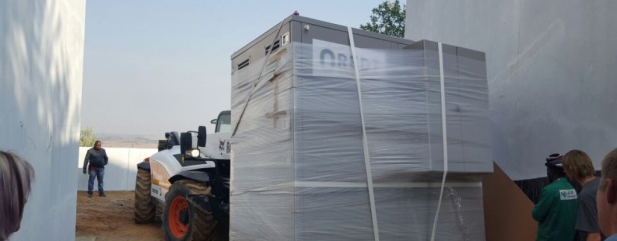Archived article
Please note that tax, investment, pension and ISA rules can change and the information and any views contained in this article may now be inaccurate.
RedT looking for power surge

Driving down the cost of manufacturing its vanadium redox flow energy storage units has been a major focus for RedT Energy (RED:AIM) over the past year or so, and management remain hugely optimistic. Success here will help a market seeding programme now in progress, and more crucially, accelerate commercial units sales that will put the company on a firm path to profits.
It has some way to go. Half year results to 30 June showed still modest revenues of €4.5m (it reports in euros) and after stripping out cost of sales and admin expenses, it left the £62m firm nursing a loss before tax of a little more than €2.5m. During the period €3.6m of cash was chewed through leaving about €5.5m net cash on the books, and that's including the £3.5m (approximately €3.9m) of fresh funding raised in January this year. A further growth cash call early in 2017 looks a pretty safe assumption.

But this is not to detract from enormous strategic progress over the past couple of years, a period in which the company has transformed itself into an energy storage technology pure play, or very nearly.
An energy storage solution
RedT has developed a new and proprietary energy storage technology which enables the efficient and sustainable storage of electrical energy in liquid form. It's taken something like 15 years of heavy research and development (R&D) but RedT now has viable units based on its patented vanadium redox energy storage technology, many already scattered among several customers across the globe in the utilities, renewables and telecoms industries in proof-of-concept trials.
'RedT is now focused, ungeared and has a properly developed and engineered product with which to go to market,' says Raymond Greaves, analyst at broker FinnCap. The company is closing in on completing its planned 10 'market seeding' orders with which it can showcase its technology in a wide range of applications and geographies.
The company has also started work alongside boffins at Newcastle University aimed at developing a hybrid energy storage solution that will blend its own technology with others. That's a three-year early stage R&D project that adds little to the investment case at this point.
The other part of its business, Camco Clean Energy, provides environmental and clean energy consultancy services, mainly in Africa where its roots are. But this bit looks increasingly likely to be used as a marketing workhorse on whose back the core RedT business can ride.
RedT energy storage machines use proprietary Vanadium Redox Flow Battery (VRFB) technology to efficiently and sustainably store energy in liquid form. This technology relies on the ability of Vanadium to exist in four different oxidation states (V2+, V3+, V4+, and V5+), each of which holds a different electrical charge. The electrolyte in the negative half-cell contains V3+ and V2+ ions, whilst the electrolyte in the positive half-cell contains V4+ and V5+ ions.
VRFB technology utilises the flow of this vanadium electrolyte, separated by an ion exchange membrane. A perfectly reversible electrochemical reaction allows electrical energy to be stored and subsequently returned. The setup of the electrolyte and the membrane stack can be compared to that of an engine and fuel tanks. The membrane stack (engine) delivers power rated in kilowatts (kW), while the fuel (the vanadium electrolyte) delivers energy rated in kilowatt hours (kWh).
Source: RedT Energy
Manufacturing muscle
Having signed a manufacturing contract with New York-listed Jabil Circuit, the global electronics and engineering manufacturer, RedT has developed containerised, modular energy storage machines. This standardised modular design means the size and cost of the energy storage machines has been driven down hard while additional functionality and usability features have been built in.
But perhaps most importantly for the future, a modular system means units are easier to transport, install, maintain and decommission at the end of their useful life, which should make using them a far more attractive proposition for potential customers.
What is the cost?
CEO Scott McGregor steers away from details of the implied costs of its generation one (Gen 1) units, claiming that the information is locked into commercially sensitive arrangements with current trial partners, including European energy giant E.ON. But the CEO has explained that its latest units, the Gen 2, are operating on a rough $700 per KWh (kilowatt hour), importantly a low enough cost, in McGregor's view, for mass market take-up.
That progress has largely come from adapting parts and streamlining manufacturing, mainly of the electrode and membrane 'stack' components, and of the electrolytes, the tanks of chemically charged liquids. Work is already under way on Gen 3 and Gen 4 versions, and potentially this could cut the KWh cost still further.
Which means this year and 2017 are largely about steady scale-up of units volumes while still driving further manufacturing cost down. FinnCap anticipates rapid volume growth to kick-in through 2018.

A unique energy storage play on the UK stock market, at 13.62p RedT is a high risk but potentially high reward investment option at this stage. FinnCap analysts were looking for revenues of €4.6m in 2016, a figure virtually hit in the first half, although that may suggest some agreements came in early. Even so, it does raise confidence in the broker's €23.9 million turnover estimate for 2017, although maiden profits are unlikely until 2018 and beyond. Which means cash burn and the prospects for shareholders to continue carrying losses and feeding further cash in are the big question marks for potential investors. Definitely one to watch, although more conservative investors will probably be more comfortable looking on from the sidelines until there is greater clarity on the strategy's success.
Important information:
These articles are provided by Shares magazine which is published by AJ Bell Media, a part of AJ Bell. Shares is not written by AJ Bell.
Shares is provided for your general information and use and is not a personal recommendation to invest. It is not intended to be relied upon by you in making or not making any investment decisions. The investments referred to in these articles will not be suitable for all investors. If in doubt please seek appropriate independent financial advice.
Investors acting on the information in these articles do so at their own risk and AJ Bell Media and its staff do not accept liability for losses suffered by investors as a result of their investment decisions.

 magazine
magazine









